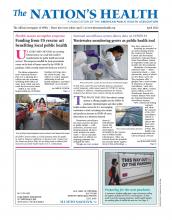
In July 2020, Zach Wu and Gabriela Esparza, wastewater control inspectors, collect sewer water for COVID-19 testing in Oakland, California. Sampling wastewater for disease indicators has become more common during the pandemic.
Photo by Paul Chinn, courtesy The San Francisco Chronicle/Getty Images
The waste that fills the nation’s sewage systems is offering insights into the COVID-19 pandemic. Epidemiologists and other public health workers across the U.S. are sampling wastewater to track circulating virus strains and predict an increase in COVID-19 cases, often before it is otherwise detected.
Wastewater surveillance has been used for decades in public health — with poliovirus, norovirus and pharmaceuticals all previously tracked via wastewater — but its real-time application to address an ongoing pandemic has changed the field.
“People are very excited about it,” said Julianne Nassif, MS, director of environmental health for the Association of Public Health Laboratories. “They are excited about the possibilities and the future applications of this technology — they have embraced it.”
Realizing its potential as an early-warning system, the Centers for Disease Control and Prevention launched a National Wastewater Surveillance System in September 2020, just six months into the pandemic.
Hundreds of wastewater collection sites — called wastewater sheds — exist nationwide, many of which are less than a year old. The programs offer “a glimpse into a new frontier of infectious of disease surveillance,” said Amy Kirby, PhD, MPH, a senior service fellow in CDC’s Waterborne Disease Prevention Branch who leads the National Wastewater Surveillance System.
New commercial testing contracts will allow the capacity of the CDC surveillance system to expand to almost 500 more sites, Brian Katzowitz, MS, health communications specialist for CDC’s Division of Foodborne, Waterborne and Environmental Diseases, told The Nation’s Health.
One of the reasons for the popularity of wastewater sampling programs is that they do not require many public health labs to invest in unfamiliar or specialized equipment. Wastewater samples are analyzed in a similar way as PCR samples, which are used for diagnosing infections with the virus that causes COVID-19.
As delta and omicron variants began to spread in the U.S., wastewater surveillance was able to detect where infections were beginning to spread. In a January study in Morbidity and Mortality Weekly Report, researchers reported that wastewater surveillance detected the omicron variant at least a week before the first case was reported by a PCR test.
“These data are uniquely powerful because they capture the presence of infections from people with and without symptoms — and they’re not affected by access to health care or availability of clinical testing,” Kirby said during a February news briefing.
On Feb. 4, CDC announced it would begin including information gathered from wastewater samples in its national COVID-19 data dashboard.
CDC’s National Wastewater Surveillance System is not only aggregating the data, but actively pushing resources toward establishing wastewater testing sites across the country. By the time of the February announcement, it had assisted 37 states, five cities and two territories in establishing programs.

Wastewater operator Allan Matovu-Barigye collects untreated wastewater at the Ballenger-McKinney wastewater treatment facility in December 2020 in Frederick, Maryland. Twice a week, samples are collected and sent to a lab to be screened for COVID-19. The wastewater samples are a window into the prevalence of infections before people show symptoms.
Photo by Katherine Frey, courtesy The Washington Post/Getty Images
“This kind of surveillance has the potential for being a sentinel — an early warning system,” Nassif told The Nation’s Health.
California officials will be relying on that science in its work to address COVID-19. On Feb. 17, California Gov. Gavin Newsome announced the state would shift its COVID-19 response strategy to focus on preparedness and prevention. One of the foundations of the plan is leveraging wastewater surveillance programs across the state. Data from California’s wastewater sheds will be used to inform decisions about how the state will manage its resources, including a standby force of 3,000 clinical staff.
Minnesota is also gaining insights from its wastewater program, which publishes data online weekly. A partnership between the Minnesota Department of Health and the University of Minnesota-Duluth has made a robust program possible, said Mark Osborn, PhD, an associate professor at the University of Minnesota Medical School.
“A wastewater program requires dedicated sampling, infrastructure, technical expertise and analytics,” Osborn told The Nation’s Health.
The arrangement includes a laboratory on campus that serves as centralized facilities for testing wastewater samples full-time, allowing other labs to maintain focus on clinical testing.
State and local health departments across the U.S. could use wastewater surveillance to watch for a variety of other pathogens. CDC has targeted influenza monitoring as the next evolution of its program. Further growth could include detecting foodborne illnesses and other infectious diseases.
Minnesota officials are interested in growing their program to monitor seasonal flu and other pathogens.
“One of the strengths of wastewater surveillance is that it is very flexible,” Kirby said.

Wastewater sampling in the U.S. is being used to monitor COVID-19, and has potential to track other health threats.
Photo by Smith Collection, courtesy Gado/Getty Images
For more information, visit www.cdc.gov/healthywater
Editor’s note: This article was corrected post-publication.
- Copyright The Nation’s Health, American Public Health Association









